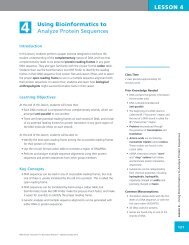WET LAB DNA Barcoding: From Samples to Sequences - Northwest ...
WET LAB DNA Barcoding: From Samples to Sequences - Northwest ...
WET LAB DNA Barcoding: From Samples to Sequences - Northwest ...
You also want an ePaper? Increase the reach of your titles
YUMPU automatically turns print PDFs into web optimized ePapers that Google loves.
<strong>WET</strong> <strong>LAB</strong><br />
[Note: Do not mix primer pool COI-2 and<br />
COI-3 <strong>to</strong>gether in a single PCR reaction.]<br />
Thermocycler: Type of machine used <strong>to</strong><br />
au<strong>to</strong>mate polymerase chain reaction that<br />
cycles through all of the temperatures<br />
required <strong>to</strong> complete the PCR.<br />
16. Pass out Student Handout–Copying the <strong>DNA</strong> <strong>Barcoding</strong> Gene Using<br />
Polymerase Chain Reaction (PCR). Have students work through the activity<br />
in small groups of up <strong>to</strong> 4 students each. If students are working with many<br />
different types of samples, have those working with the same primer pools<br />
work <strong>to</strong>gether (i.e., all of the students using Primer Pool COI-2 for fish in one<br />
group, and all of the students using Primer Pool COI-3 for reptiles in another<br />
group). Alternatively, if pairs or groups of students are working with the same<br />
sample (i.e., the same organism from which the <strong>DNA</strong> was purified), one or<br />
more members of the group may try the PCR with one primer pool (Primer<br />
Pool COI-2), while the other member(s) of the group try the PCR with the<br />
other primer pool (Primer Pool COI-3).<br />
17. Once students have assembled their PCR, help them place their PCR tubes in<br />
the thermocycler. Teachers are encouraged <strong>to</strong> create a template or table of<br />
their thermocycler for students <strong>to</strong> record where they placed their tubes, such<br />
as the ones shown in Figure 1. Note that different types of thermocyclers<br />
have capacities for different numbers of PCR tubes (usually 24, 36, or 96).<br />
Figure 1: Examples of Tables or Templates of Student <strong>Samples</strong> in a 24-tube (left) or 96-tube (right)<br />
Thermocycler. Note that Each Cell Contains the Initials and Sample Number of Different Students.<br />
Using Bioinformatics: Genetic Research<br />
18. The PCR experiment in the thermocycler will likely run for 2–3 hours. Most<br />
machines have an option <strong>to</strong> keep samples at 4°C indefinitely at the end<br />
of the PCR reaction run, so that the reaction may be run overnight or over<br />
the weekend. Tubes can be removed from the machine and placed in the<br />
refrigera<strong>to</strong>r (short term, up <strong>to</strong> 3 days) or freezer (long term, more 3 days).<br />
332<br />
©<strong>Northwest</strong> Association for Biomedical Research—Updated Oc<strong>to</strong>ber 2012
















